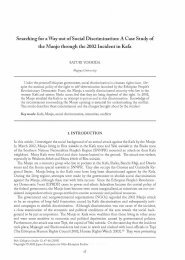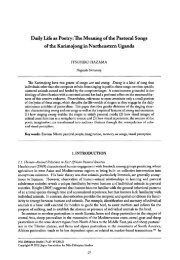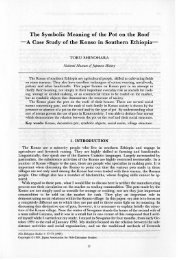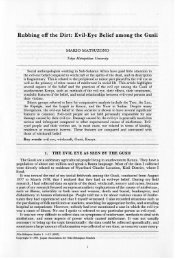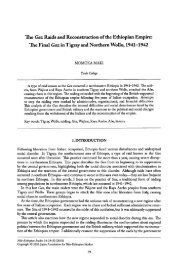Northern Ethiopian Historiography during the Second Half of the ...
Northern Ethiopian Historiography during the Second Half of the ...
Northern Ethiopian Historiography during the Second Half of the ...
You also want an ePaper? Increase the reach of your titles
YUMPU automatically turns print PDFs into web optimized ePapers that Google loves.
10 Nilo-<strong>Ethiopian</strong> Studies<br />
is one <strong>of</strong> <strong>the</strong> earliest Arabic histories brought to Europe, and it played an important role in <strong>the</strong> study <strong>of</strong><br />
Islam in Europe (Cahen &Coquin 1991: 143).<br />
(11) Translation in o~·~z <strong>of</strong> The Collection <strong>of</strong> $aft (AI-Majmu' al-$afowi) written by Al-$afi b. al-~ssal in<br />
Arabic for <strong>the</strong> Copts. This work is a collection <strong>of</strong> canon laws as well as civil and penal legislation, and it<br />
influenced <strong>the</strong> customs and civil and penal laws in nor<strong>the</strong>rn Ethiopia (Guidi 1932: 78-79; Cerulli 1968:<br />
176-177).<br />
(12) For example, MS Bruce 88 <strong>of</strong> <strong>the</strong> Bodleian Library included <strong>the</strong> royal chronicles from ~mda $~yon<br />
(r. 1314-1344) to Sfuia D;:,ng;:,l. This manuscript explained <strong>the</strong> dates <strong>of</strong> principal events in <strong>the</strong> Old<br />
Testament on <strong>the</strong> basis <strong>of</strong> Makin's chronology (MS Bruce 88, fols. 3v-4v).<br />
(13) After <strong>the</strong> death <strong>of</strong> Makin, Mufa~~al b. Abi '1-Fa~a'il finished <strong>the</strong> unwritten work <strong>of</strong> this author<br />
(Brockelmann 1943-1949 1: 425-426). Or. 814 seems to be <strong>the</strong> translation into G;:,';:,z <strong>of</strong> this revised<br />
edition.<br />
(14) If <strong>the</strong> book consulted by Babr.)y was <strong>the</strong> work <strong>of</strong>Makin, it seems to be <strong>the</strong> revised edition that was based<br />
on <strong>the</strong> edition by Mufa~~al b.Abi '1-Fa~a'il and that added <strong>the</strong> history <strong>of</strong> <strong>the</strong> Islamic world from <strong>the</strong> 14th<br />
to <strong>the</strong> 16th centuries. However, it may be ano<strong>the</strong>r book that included <strong>the</strong> Persian kings.<br />
(15) Chernetsov referred to <strong>the</strong> chronicles <strong>of</strong> Sfuia D~ng;:,l and Susn;:,yos as historiography <strong>of</strong> "Medieval<br />
Ethiopia." His definition <strong>of</strong> Medieval Ethiopia is not clear, although it included <strong>the</strong>se monarchs' reigns.<br />
(16) Yasbaq was <strong>the</strong> governor <strong>of</strong> Bal)rm;:,dr, and he fought against <strong>the</strong> Ottoman troops who attempted to<br />
conquer <strong>the</strong> <strong>Ethiopian</strong> plateau <strong>during</strong> <strong>the</strong> reign <strong>of</strong> Minas (r. 1559-1563). Mter <strong>the</strong> death <strong>of</strong> Minas, he<br />
entered into an alliance with Ottomans and rebelled against SaJia D;:,ng~l.<br />
In 1579, he was killed by <strong>the</strong><br />
royal army.<br />
(17) Babr.)y was appointed to <strong>the</strong> important <strong>of</strong>fice <strong>of</strong>"K.ing's Priest (qes bl#e)" at <strong>the</strong> end <strong>of</strong> <strong>the</strong> reign <strong>of</strong>Sfuia<br />
D;:,ng;:,l (Conti Rossini 1893: 805). As Chernetsov proposed, Babr.)y may have been <strong>the</strong> author <strong>of</strong> this<br />
monarch's chronicle. In that case, he followed <strong>the</strong> custom <strong>of</strong> writing histories in <strong>the</strong> <strong>of</strong>ficial chronicle and<br />
expressed his own opinions in The History <strong>of</strong> <strong>the</strong> Galla. This hypo<strong>the</strong>sis requires fur<strong>the</strong>r consideration.<br />
(18) AM (i.e., Anno Mundi). In <strong>the</strong> past, several eras were widely used in nor<strong>the</strong>rn Ethiopia to number years.<br />
(19) Masib Sagad was <strong>the</strong> throne name <strong>of</strong>Bakaffa.<br />
(20) Amharic was <strong>the</strong> principal spoken language, and G;:,'~z was <strong>the</strong> written language in <strong>the</strong> Christian kingdom<br />
<strong>of</strong> nor<strong>the</strong>rn Ethiopia. Amharic-speaking people needed to study G;:,';:,z to understand <strong>the</strong> books<br />
written in G;:,';:,z (Pais 1945-1946 1: 189190; Beccari 1969 II: 221-222). Therefore, most people listened<br />
to ra<strong>the</strong>r than read <strong>the</strong> royal chronicles.<br />
(21) Balaw is <strong>the</strong> name <strong>of</strong> an ethnic group living in <strong>the</strong> borderland between <strong>the</strong> <strong>Ethiopian</strong> kingdom and <strong>the</strong><br />
Sennar kingdom <strong>of</strong> Sudan. Iyasu II conducted military expeditions against this group and suffered a<br />
crushing defeat in 1744 (Bruce 1790 II: 635-641; Guidi 1954-1962 I: 114-115).<br />
(22) See <strong>the</strong> explanation provided by Huntingford (Huntingford 1989: 151-234) regarding <strong>the</strong> military expeditions<br />
conducted by <strong>the</strong>se monarchs.<br />
(23) According to Chapters 23 and 53 <strong>of</strong> The Chronicle <strong>of</strong> Susnayos, M;:,hreka D;:,ng;:,l started to write this<br />
chronicle, and Takla S;:,llase was <strong>the</strong> author <strong>of</strong>latter part (Esteves Pereira 1892-1900 I: 70, 208).<br />
(24) S;:,ltan Sagad was <strong>the</strong> throne name <strong>of</strong>Susn~yos.<br />
(25) "Tino" is an epi<strong>the</strong>t referring to Takla S~llase, meaning "small," in <strong>the</strong> Oromo language (Foot 1970: 53;<br />
Tilahun 1989: 556; Borello 1995: 395).<br />
(26) Until <strong>the</strong> introduction <strong>of</strong> European-style schools, <strong>the</strong> <strong>Ethiopian</strong> Church played a principal role in education<br />
in nor<strong>the</strong>rn Ethiopia. To understand <strong>the</strong> influence <strong>of</strong> Christianity on nor<strong>the</strong>rn <strong>Ethiopian</strong> historiography,<br />
it is important to examine <strong>the</strong> relationship between historians and <strong>the</strong>ir education. See <strong>the</strong><br />
explanation provided by O'Hanlon and Imbakom Kalewold (O'Hanlon 1946: 13-21; Imbakom Kalewold<br />
1970) regarding church education in nor<strong>the</strong>rn Ethiopia.<br />
REFERENCES<br />
Abmad Tafazzoli<br />
1999 s. v. Ferediin. In Ehsan Yarshater (ed.), Encyclopaedia Iranica. New York: Biblio<strong>the</strong>ca Persica Press,<br />
vol. 9, pp. 531-533.




